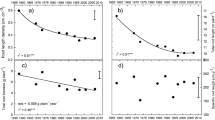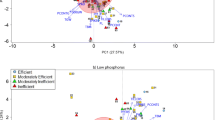Abstract
Wild emmer wheat, Triticum dicoccoides, grows naturally in several habitats in northern Israel. The assumption that a genotype is better adapted to the `native' soil from which it was collected than to other soils, was tested. Each of nine T. dicoccoides accessions from nine different habitats and three wheat cultivars was sown in soils taken from all habitats, and grown in a greenhouse over 3 years. To enhance the biological nutrition absorption forces from the soil, three common wheat cultivars were added to the wild genotypes. No interaction in grain yield between wild wheat genotype and soil type was found within experiments. Soil type was the main factor that affected development and yield. Seed nutrient ability (SNA) of each soil was defined as the mineral element content in the seeds, averaged over all genotypes. Multiple regression analysis revealed diversity between the SNA related to growth and yield of the genotypes. Total seed yield per plant of each accession was related to several SNAs, and mainly to S and K, R2 = 0.5–0.85. The spikelet number per spike was determined by N and Na in five accessions and by Ca in the other four (R2 = 0.39–0.93).Heading date was affected mainly by the genotype, and the soil effect exhibited Fe and P dependence. A genotype-habitat adaptation exhibited by yield components was related to yield quality rather than to yield quantity. When a mineral nutrient is deficient in a natural soil, natural selection leads to establishment of plants that store a higher concentration of that nutrient in the seed, for the benefit of the succeeding generation.
Similar content being viewed by others
References
Berg, W.A., M.E. Hodges & E.G. Krenzer, 1993. Iron deficiency in wheat grown on the southern plains. J Plant Nutr 16: 1241–1248.
Bohnert, H.A., D.E. Nelson & R.G. Jensen, 1995. Adaptation to environmental stresses. Plant Cell 7: 1099–1111.
Boila, R.J., L.D. Campbell, S.C. Stothers, G.H. Crow & E.A. Ibrahim, 1993. Variation in the mineral content of cereal grains grown at selected locations throughout Manitoba. Can J Anim Sci 73: 421–429.
Bonfil, D.J., 1994. Gluten components of wild wheat Triticum turgidum var. dicoccoides as affected by the different soil types in the Galilee and the Golan. PhD. Thesis. The Hebrew University of Jerusalem, Rehovot, Israel. 104 pp. Hebrew, with English summary.
Bonfil, D.J., H. Czosnek & U. Kafkafi, 1997. Wheat seed storage protein fingerprint changes due to soil types and their mineral content. Euphytica 95: 209–219.
Bonfil, D.J. & U. Kafkafi, 1995. Plant genotype effects on efficient use of plant nutrients. Proc. 24th Colloquium International Potash Institute, Chiang Mai, Thailand. pp. 557–573.
Bonfil, D.J. & U. Kafkafi, 1999. Nutrient composition diversity in wild and common wheat grains. In: G. Gissel-Nielsen & A. Jensen (Eds.), Proceedings of the Sixth International Symposium on Genetics and Molecular Biology of Plant Nutrition. Kluwer Academic Publishers, Dordrecht, The Netherlands. pp. 25–33.
Burgess, J.L., 1911. The influence of the soil type on the plant variety. Agron J 3: 58–72.
Chapin, F.S. III, 1980. The mineral nutrition of wild plants. Annu Rev Ecol Syst 11: 233–260.
Ciaffi, M., S. Benedettelli, B. Giorgi, E. Porceddu & D. Lafiandra, 1991. Seed storage proteins of Triticum turgidum ssp. dicoccoides and their effect on the technological quality in durum wheat. Plant Breeding 107: 309–319.
Ciaffi, M., L. Dominici, D. Lafiandra & E. Porceddu, 1992. Seed storage proteins of wild wheat progenitors and their relationships with technological properties. Hereditas 116: 315–322.
Dan, Y., D.H. Yaalon, H. Koyumdjisky & Z. Raz, 1976. The Soils of Israel (with map 1:500000). Division of Scientific Publications, Pamphlet No. 159. Agric. Res. Organization (ARO), The Volcani Center, Bet Dagan, Israel.
Feldman, M. & E.R. Sears, 1981. The wild gene resources of wheat. Sci Am 244: 98–109.
Goos, R.J., D.G. Westfall, A.E. Ludwick & J.E. Goris, 1982. Grain protein content as an indicator of N sufficiency for winter wheat. Agron J 74: 130–133.
Gorham, J., 1993. Genetics and physiology of enhanced K/Na discrimination. In: P.J. Randall (Ed.), Genetics Aspects of Plant Mineral Nutrition, pp. 151–158. Kluwer Academic Publishers, Dordrecht, The Netherlands.
Grama, A., N.G. Porter & D.S.C. Wright, 1987. Hexaploid wild emmer wheat derivatives grown under New Zealand conditions. 2. Effect of foliar urea sprays on plant and grain nitrogen and baking quality. NZ J Agric Res 30: 45–51.
Henkin, Z., I. Noy-Meir, U. Kafkafi, N. Seligman & M. Gutman, 1994. Soil phosphorus in a managed Mediterranean woodland ecosystem: herbage response and cattle grazing effects. Agric Ecosyst Environ 47: 299–311.
Jones, J.B. Jr. & V.W. Case, 1990. Sampling, handling, and analyzing plant tissue samples. In: R.L. Westerman (Ed.), Soil Testing and Plant Analysis, 3rd edn, pp. 389–427. SSSA Book Series, no. 3 Madison, WI.
Kagan, J. & J. Ephrat, 1974. The effect of NPK fertilization and of manure on yield, yield components, and development parameters of wheat. Hassadeh 55: 331–392. (Hebrew, with English abstr.).
Moussavi-Nik, M., Z. Rengel, G.J. Hollamby & J.S. Ascher, 1997. Seed manganese (Mn) content is more important than Mn fertilization for wheat growth under Mn deficient conditions. In: T. Ando (Ed.), Plant Nutrition-for Sustainable Food Production and Environment, pp. 267–268. Kluwer Academic Press, Japan.
Nambiar, E.K.S., 1976. Genetic difference in the copper nutrition of cereals. I. Differential responses of genotypes to copper. Aust J Agric Res 27: 453–463.
Nevo, E., 1986. Genetic resources of wild cereals and crop improvement: Israel, a natural laboratory. Isr J Bot 35: 255–278.
Nevo, E. & A. Beiles, 1989. Genetic diversity of wild emmer wheat in Israel and Turkey. Structure, evolution, and application in breeding. Theor Appl Genet 77: 421–455.
Nevo, E. & P.I. Payne, 1987. Wheat storage proteins: diversity of HMW glutenin subunits in wild emmer from Israel. 1. Geographical patterns and ecological predictability. Theor Appl Genet 74: 827–836.
Pearson, J.N. & Z. Rengel, 1995. Uptake and distribution of 65Zn and 54Mn in wheat grown at sufficient and deficient levels of Zn and Mn. II. During grain development. J Exp Bot 46: 841–845.
Pinthus, M.J., 1985. Triticum. In: A.H. Halevy (Ed.), Handbook of Flowering, Vol. IV, pp. 418–443. CRC Press, Boca Raton, Fl, USA.
Rabinovitch-Vin, A., 1983. Influence of nutrients on composition and distribution of plant communities in mediterranean ecosystems of Israel. In: S.J. Kruger, D.T. Mitchell & J.U.M. Jarvis (Eds.), Ecological Studies, Vol. 43, pp. 74–85. Springer-Verlag, Berlin, Germany.
Randall, P.J. & C.W. Wrigley, 1986. Effects of sulphur supply on the yield, composition, and quality of grain from cereals, oilseeds, and legumes. Adv Cereal Sci Technol 8: 171–206.
Rengel, Z. & R.D. Graham, 1995. Importance of seed Zn content for wheat growth on Zn-deficient soil. II. Grain yield. Plant Soil 173: 267–274.
Sherchand, K. & G.M. Paulsen, 1985. Genotypic variation in partitioning of phosphorus in relation to nitrogen and dry matter during wheat grain development. J Plant Nutr 8: 1161–1170.
Shimizu, M., 1960. Effect of nitrogen, phosphorus and potassium on spike differentiation and development in wheat plants. Jap J Breed 10: 179–187 (Japanese, with English summary).
Silberbush, M., Y. Waisel & U. Kafkafi, 1981. The role of soil phosphorus in differentiation of edaphic ecotypes in Aegilops peregrina. Oecologia 49: 419–424.
Smith, V.R., 1980. A phenol-hypochlorite manual determination of ammonium-nitrogen in Kjeldahl digests of plant tissue. Commun Soil Sci Plant Anal 11: 709–722.
Snaydon, R.W. & A.D. Bradshaw, 1962. Differences between natural populations of Trifolium repens L. in response to mineral nutrients. I. Phosphate. Exp Bot 13: 422–434.
Van Oosterom, E.J., D. Kleijn, S. Ceccarelli & M.M. Nachit, 1993. Genotype-by-environment interactions of barley in the Mediterranean region. Crop Sci 33: 669–674.
Vose, P.B., 1990. Screening techniques for plant nutrient efficiency: Philosophy and methods. In: N. El Bassam, M. Dambroth & B.C. Loughman (Eds.), Genetics Aspects of Plant Mineral Nutrition, pp. 283–289. Kluwer Academic Press, Dordrecht, The Netherlands.
Westcott, B., 1986. Some methods of analysing genotype-environment interactions. Heredity 56: 243–253.
Wiese, M.V., 1993. Wheat and other small grains. In: W.F. Bennett (Ed.), Nutrient Deficiencies and Toxicities in Crop Plants, pp. 27–33. APS Press, St. Paul, MN, USA.
Yilmaz, A., H. Ekiz, I. Gültekin, B. Torun, S. Karanlik & I. Cakmak, 1997. Effect of zinc content on grain yield and zinc concentration of wheat grown in zinc-deficient calcareous soils. In: T. Ando (Ed.), Plant Nutrition-for Sustainable Food Production and Environment, pp. 283–284. Kluwer Academic Press, Japan.
Author information
Authors and Affiliations
Rights and permissions
About this article
Cite this article
Bonfil, D.J., Kafkafi, U. Wild wheat adaptation in different soil ecosystems as expressed in the mineral concentration of the seeds. Euphytica 114, 123–134 (2000). https://doi.org/10.1023/A:1003989829539
Issue Date:
DOI: https://doi.org/10.1023/A:1003989829539




